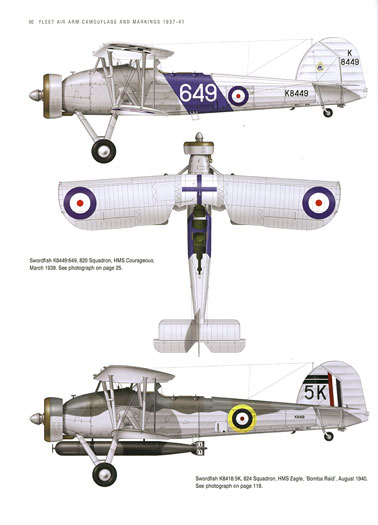|
S u m m a
r y
|
|
Title and Author |
Fleet Air Arm Camouflage and Markings Atlantic & Mediterranean Theatres 1937-1941
by Stuart Lloyd
Dalrymple & Verdun Publishing, 2008 |
| ISBN: |
1-905414-08-6 |
| Media: |
Soft, glossy, laminated covers; 21cm x 28cm portrait format, 152 good quality satin-finish pages. Twelve pages of colour profiles, plus nearly 170 reference photographs. |
| Price: |
GBP£24.95 plus
post and packing |
| Review Type: |
First Read |
|
Advantages: |
Comprehensive explanation of a complex and fascinating subject. Excellent photographic references and colour aircraft profiles. |
|
Disadvantages: |
|
|
Recommendation: |
Recommended |
Reviewed by Steve Naylor

HyperScale is proudly supported by Squadron.com
There can be few topics, guaranteed to perplex the aviation historian and modeller alike, than the debate surrounding aircraft camouflage and markings. Whilst many periods in aviation history and indeed, many aircraft, have provided ample scope for discourse on this topic, the UK's Fleet Air Arm is perhaps the one service most veiled in confusion and mystery. Stepping bravely into this hotbed of contention is author Stuart Lloyd who, in attempting to put all this into some sort of context, takes us through the early period of FAA history in Dalrymple & Verdun's latest title, 'Fleet Air Arm Camouflage and Markings - Atlantic and Mediterranean Theatres 1937-1941'.
 Given the 'weighty' subject matter, this new book 'weighs-in' at 152 pages, being just under A4 in size with soft glossy covers. These covers may look somewhat muted, but this is entirely commensurate with the fact that we are firmly in the black & white era, in terms of the available photographic archive. This is alleviated however, by the welcome splashes of colour provided in Richard J Caruana's excellent aircraft profiles and by the inclusion of images showing the actual watercolour camouflage doping schemes ('Air Diagrams'), issued by the Admiralty during the period under discussion. Printing is, as we have by now come to expect in these titles, 'two-columns-per-page', on good-quality, semi-gloss/satin pages. Given the 'weighty' subject matter, this new book 'weighs-in' at 152 pages, being just under A4 in size with soft glossy covers. These covers may look somewhat muted, but this is entirely commensurate with the fact that we are firmly in the black & white era, in terms of the available photographic archive. This is alleviated however, by the welcome splashes of colour provided in Richard J Caruana's excellent aircraft profiles and by the inclusion of images showing the actual watercolour camouflage doping schemes ('Air Diagrams'), issued by the Admiralty during the period under discussion. Printing is, as we have by now come to expect in these titles, 'two-columns-per-page', on good-quality, semi-gloss/satin pages.
After the brief preface and introduction, the main subject matter is covered in five main chapters;
-
Experiments With Camouflage
-
The Gathering Storm
-
The Fleet Air Arm at War
-
Temperate Sea Scheme
-
Camouflage and Markings by Aircraft Type
The book ends with an appendix and an index, the former being a useful piece on the interpretation of black and white photographs taken with different film stock, illustrated by three different photographs of the same aircraft (Skua).
Needless to say, the story of camouflage and marking in the Fleet Air Arm is both complicated and confusing, exacerbated by the inherently disjointed hierarchy of authority at the time (Air Ministry, Admiralty and RAF among others) and the inevitable interpretation (or mis-interpretation) of the resultant directives. There is little point in this reviewer even attempting to convey the complexity of the issues involved, that would be for the reader to discover, suffice to say that this book is an authoritative and scholarly work, but whilst there is an underlying and fascinating narrative, it is nevertheless understandably 'heavy-going' on occasion, for the casual reader. That said, the text is a gold mine of invaluable information, which the diligent reader, or modeller, will find very useful.
Finally, backing up all the text, there are nearly 170 black and white photographs, not only of the aircraft themselves, but also of the ships on which they were embarked. These are, for the most part, excellent quality, though some poorer ones are included, due to their unique or rare content. Photographs are sourced from private and public collections, with the majority coming from the Fleet Air Arm Museum, who's research staff have evidently been invaluable in the creation of this book.
If you are a fan of the Fleet Air Arm and its history, then it goes without saying, that this is a 'must-have' book.
The author skilfully steers the reader through the myriad of experiments, instructions, interpretations and ructions, though the 'going' is sometimes hard. By way of compensation, for those interested in a particular aircraft of the period (Swordfish, Sea Gladiator, Skua, Fulmar, Albacore and Martlet), chapter five does at least provide a type-specific explanation, of the schemes discussed at some length in the earlier chapters. All this is accompanied by a fascinating collection of archive photographs, and it is particularly interesting to see images of the schemes worn by the Royal Navy vessels of the period.
Not, perhaps, a book for the casual reader, but invaluable for those with an interest in 'Senior Service' aviation. Perhaps if we are very lucky, this story will be continued in future volumes.
Highly Recommended.
Thanks to Dalrymple & Verdun Publishing for the
review sample
Copies should be available to
order from most good book retailers, but can also be ordered
direct from:
Dalrymple & Verdun Publishing
33 Adelaide Street
Stamford
Lincolnshire
England
PE9 2EN
(UK)
mail@dvpublishing.co.uk
www.dvpublishing.co.uk
Review Copyright © 2008 by
Steve Naylor
This Page Created on 24 March, 2008
Last updated
24 March, 2008
Back to HyperScale
Main Page
|
